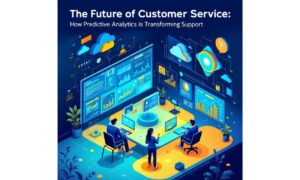Introduction
Artificial Intelligence (AI) and Predictive Analytics are two of the most revolutionary tools in the retail industry today. AI is a term that describes computer systems that can learn, reason, and act like humans. Predictive analytics is the process of using data to predict future outcomes and trends. Together, these two technologies are transforming how businesses operate in the retail sector by providing insights into customer behavior, predicting sales forecasts, optimizing supply chain management, and more.
Definition of AI and Predictive Analytics
AI is a type of computer programming designed to mimic human intelligence. It consists of algorithms that enable machines to remember past experiences and use them to make decisions without direct human input or intervention. Common examples include facial recognition software or autonomous vehicles.
Predictive analytics is an area within data science that uses statistical models to analyze current data points to make predictions about future events or trends. By analyzing historical information such as customer purchases, demographics, or other behaviors related to products sold in stores, businesses can gain valuable insight into consumer preferences which can be used for marketing campaigns or product development purposes. Retail predictive analytics is an invaluable tool for modern businesses, providing valuable insights into customer behavior and allowing retailers to make informed decisions that drive their bottom line.
Benefits of AI and Predictive Analytics in Retail
The rise of artificial intelligence (AI) and predictive analytics has had a major impact on the retail industry. By leveraging these technologies, retailers can gain valuable insights into customer behavior and preferences, enabling them to improve customer experience, increase efficiency and productivity, and enhance business performance.
Improved Customer Experience
AI and predictive analytics can help retailers provide a more personalized shopping experience for their customers. With AI-powered tools such as natural language processing (NLP), machine learning algorithms, and computer vision technology, retailers can better understand customer needs by analyzing past purchasing patterns. This allows them to create targeted marketing campaigns that are tailored specifically to each consumer’s interests or preferences. Additionally, AI-driven chatbots can provide customers with quick answers to simple questions about products or services without requiring them to wait for an employee response time.
Increased Efficiency & Productivity
AI-driven systems allow retailers to automate certain tasks such as inventory management or order fulfillment processes which helps save time and money spent on manual labor costs in the long run. Furthermore, AI-enabled robots can be used for product stocking purposes which helps increase accuracy when it comes to inventory levels being maintained in stores at any given moment.
Challenges in Implementing AI and Predictive Analytics in Retail
The retail industry is one of the most competitive industries in the world, and businesses must constantly stay ahead of their competition by leveraging the latest technologies. Artificial intelligence (AI) and predictive analytics are two such technologies that have been gaining a lot of traction in recent years. While these tools have great potential for improving efficiency and driving success in retail, there are some challenges associated with implementing them.
First, AI and predictive analytics require a large amount of data to be effective. For this reason, retailers need to be able to collect and store large amounts of data from customers, suppliers, competitors, and more. Additionally, collecting this data can pose privacy concerns for both customers and employees which can make it difficult for businesses to implement these technologies without facing legal or ethical issues.
Second, AI algorithms require extensive training before they can accurately predict consumer behavior or other trends that might benefit retailers greatly. This requires significant expertise which can be expensive if businesses do not already have experienced professionals on staff who understand how to use these tools effectively. Additionally, even when trained correctly AI algorithms may still produce inaccurate results due to changes in customer behavior over time or other factors outside of the algorithm’s control which makes it difficult for businesses to trust these insights completely when making decisions about their operations.
Conclusion
AI predictive analytics for retail has become an increasingly important tool in the modern retail landscape. It can help retailers forecast future trends, identify customer preferences, and optimize pricing and inventory levels. By utilizing AI predictive analytics for retail, retailers can gain a competitive edge as they are better positioned to anticipate market changes and meet customers’ demands. Overall, AI predictive analytics enables retailers to make smarter decisions that will result in increased profits and customer satisfaction.





































